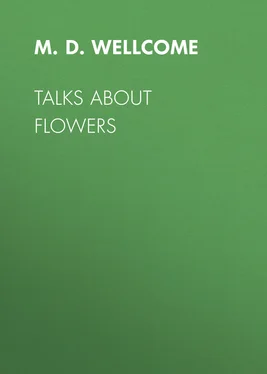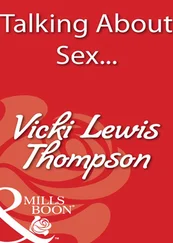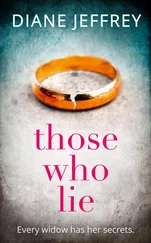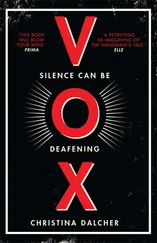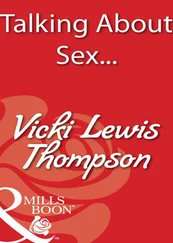M. D. Wellcome - Talks About Flowers
Здесь есть возможность читать онлайн «M. D. Wellcome - Talks About Flowers» — ознакомительный отрывок электронной книги совершенно бесплатно, а после прочтения отрывка купить полную версию. В некоторых случаях можно слушать аудио, скачать через торрент в формате fb2 и присутствует краткое содержание. Жанр: foreign_antique, Биология, Биология, foreign_edu, на английском языке. Описание произведения, (предисловие) а так же отзывы посетителей доступны на портале библиотеки ЛибКат.
- Название:Talks About Flowers
- Автор:
- Жанр:
- Год:неизвестен
- ISBN:нет данных
- Рейтинг книги:4 / 5. Голосов: 1
-
Избранное:Добавить в избранное
- Отзывы:
-
Ваша оценка:
- 80
- 1
- 2
- 3
- 4
- 5
Talks About Flowers: краткое содержание, описание и аннотация
Предлагаем к чтению аннотацию, описание, краткое содержание или предисловие (зависит от того, что написал сам автор книги «Talks About Flowers»). Если вы не нашли необходимую информацию о книге — напишите в комментариях, мы постараемся отыскать её.
Talks About Flowers — читать онлайн ознакомительный отрывок
Ниже представлен текст книги, разбитый по страницам. Система сохранения места последней прочитанной страницы, позволяет с удобством читать онлайн бесплатно книгу «Talks About Flowers», без необходимости каждый раз заново искать на чём Вы остановились. Поставьте закладку, и сможете в любой момент перейти на страницу, на которой закончили чтение.
Интервал:
Закладка:
Of the numerous classes into which geraniums are divided, few only are given usually by florists. There are the Ornamental Foliage of which we have cited a few examples, and the Golden Tricolors, Silver Tricolors, Golden Bronze, Nosegay and Lilliputian Zonale; Double and single Geraniums.
We will specify a few varieties worthy of special note, as we can testify by personal observation. Bishop Wood, Madam Baltet, C. H. Wagner, Madam Thibaut, Victor Hugo, Jean Dolfus, Cassimer Perier, John Fennely, Naomi and Rose d'Amour, all double sorts. Of the single, Dr. John Denny possesses a rare beauty, and is thus described by an English writer: "Dr. John Denny, raised by J. Sisley, has quite set at rest the probability of a blue or a purple, which is a positive fact, and great honor is due to its distinguished raiser. It also possesses another novel and distinct feature. The base of the two top petals is of a bright crimson tinted with orange, which gives it a most striking appearance; this, together with its immense sized trusses, free growth and shape of blooms, renders it one of the best for pot or house decoration, and is of great acquisition." Jean Dolfus belongs to this purple magenta class, a double geranium, very beautiful. Also Zuleika, which has larger pips and trusses. It is a little more striking in color than John Denny, but both are just as lovely as a geranium can possibly be. When Jealousy was sent out, there was much ado over it because it was the nearest approach toward a yellow Zonal, but it was eclipsed pretty soon by Guinea, which was an advance by a shade or two. We had the two in proximity last summer, and though but little difference, it was sufficiently marked to enable us to decide that Guinea for color, size and form, was preferable. We just get settled down on that, when we are startled by the announcement of another novelty, "New Guinea" by name, "a great improvement on Guinea, being two shades brighter." Well, well! we must have that, too, and see if in other respects as well as color, it is worthy to eclipse our favorite.
Henry Cannell—this is a new geranium, originating with Mr. John Thorp of Queens, New York, who makes a specialty of seedling geraniums, and has sent out from his grounds many of great value, one of them Happy Thought, so widely known. We have not tested H. Cannell, ours was sent from Innisfallen during the winter, and has not yet bloomed, but we are sure that it would never have received the name of the most distinguished florist in England, if it were not a superior variety.
New Life originated with Mr. H. Cannell of Swanley England, in our Centennial year, and he sent out the first thousand by subscription only, at £1 each—not one sold till the thousand were engaged! When introduced the following year to this country, stock plants were sold for $5.00 each. Now you can purchase it at prices ranging from ten cents to thirty. It is unique in color, being splashed, striped, and flecked with salmon and white on an intense scarlet ground. It is sometimes freakish, having pips with some petals salmon, others partly white and partly scarlet, others pure scarlet. But this very freak is charming, for with beautifully striped trusses there will be others thus sportive. Its habit is dwarf, compact, and its dark leaves zoned with black are very handsome. It cannot be surpassed as a free bloomer. Mr. Cannell, when sending it out, expressed the wish that the day might come when there would not be a cottage in the land where New Life was not found. John Fennely, salmon striped with white, and Fairy, flaked and striped with crimson on a bluish white ground, are very pretty. Dazzle, Harry King, Richard Dean, and Jean Sisley are scarlet with white eye. Of several single white geraniums in my garden, I gave decided preference to Madame Quinet.
There is a great difference in the duration of the flowers. Victor Hugo, a splendid geranium, retains its beautiful trusses full five weeks. Bishop Wood is also admirable in this respect, and Jenny Dolfus and Naomi we believe cannot be surpassed.
Of the Sweet Scented Geraniums, we have none equal to the hybrid, Mrs. Taylor, for beauty of foliage and of flower. It is a fine grower, and for green to mix with flowers it is admirable. Dr. Livingstone, a more recent novelty, is very handsome and fragrant. Rose and Lemon scented are delicious. Lady Plymouth is a variegated rose; leaves bronzy green, fringed with creamy white, sometimes assuming a pink tinge; very ornamental. London Blue is a very rare variety of scented geranium, of heavy creeping growth, with large crimped or curled leaves covered thickly with fine spines or hairs. Seldom blooms.
We have specified a goodly number, yet but a few from the many, and we can assure you that if you have a large bed of geraniums you will greatly admire them, and feel satisfied that you have the most effective bedding plants, requiring the least care, and for the smallest outlay, that you could possibly obtain. In California they grow without culture to an enormous size. From an editor's notes we cite the following:
"A little slip of geranium planted out in the spring, had grown in the summer to 150 branches, its stalk at its base four inches thick, and bearing over a thousand blooms! I saw a fence fifteen feet high, sixty-five feet long, covered with geranium vines that had clambered up one side, and then dropped down the other, filling both sides with a blanket of scarlet blossoms. It grows like weeds, and needs no care."
Geraniums are so hardy that one can leave them to the last in removing from the border in autumn. Frosts that kill Dahlia tops, and many other plants, do not harm geraniums. Some of mine, for lack of time to remove, are exposed till late without harm. The roots have great vitality, and when the stalk has frozen and rotted to the ground, a new growth will start forth, sometimes in a few weeks, and sometimes not for three months. I have had this proved by plants in my window boxes. So one need not be in a hurry to pull up the frozen geraniums. My large stocky plants I pack in dry goods boxes, filling in earth around the roots, and put them in the cellar where they have little light. The pot plants, also, are mostly put away so as to give all the available room to the cuttings rooted in the summer, and the rare and tender plants that will not live in a cellar. These cuttings make fine plants for bedding out in May or June.
In the spring the large geraniums are brought up to the open air and trimmed of their dead leaves, pruned of dead branches, and put in a large bed with the Hybrid Perpetual Roses.
A Talk About Begonias
MY first Begonia was a Rex. It thrived for several years, and then to my regret died, for it was quite a favorite with me. Its large leaves with broad silvery belt and red dots, were very handsome. This species thrive best in a Wardian case and are of rare beauty and size, grown under such circumstances. A cool, moist atmosphere is the best for them; they burn and shrivel exposed to the intense sunlight. They are easily multiplied from the leaves. Cut the leaf so that a small portion of the stem will remain, insert this in a pan of damp sand, laying the leaf out flat upon the sand, upper side uppermost. It can be retained in place by bits of stone or small pegs. Cuts must then be made in a number of places so as to sever the veins, thus checking the flow of sap. A callus then forms at the base of each piece of vein where severed, and just above it, a bud starts out, and thus a new plant is formed. It is essential for success, that there should be bottom heat, and that the air should be moist. A bell glass is the best to put over the leaf, and if there is danger that the air become too moist, the glass can be tilted up to allow of an escape. The leaves best adapted for propagation are those neither very young nor very old, but healthy and vigorous; yet that this is not absolutely essential is shown by the experience of a lady who had excellent success with a leaf that was some what decayed around the edges, and for that reason was cut off and thrown away. Remembering afterward that the plant was sometimes grown from pieces of a leaf, she hunted it up, trimmed off the decayed portion, and planted it at the foot of a tree, about half under ground, and pressed the soil firmly around it. A few months afterward she had a nice little plant from it, with its beautiful leaves unfolding finely.
Читать дальшеИнтервал:
Закладка:
Похожие книги на «Talks About Flowers»
Представляем Вашему вниманию похожие книги на «Talks About Flowers» списком для выбора. Мы отобрали схожую по названию и смыслу литературу в надежде предоставить читателям больше вариантов отыскать новые, интересные, ещё непрочитанные произведения.
Обсуждение, отзывы о книге «Talks About Flowers» и просто собственные мнения читателей. Оставьте ваши комментарии, напишите, что Вы думаете о произведении, его смысле или главных героях. Укажите что конкретно понравилось, а что нет, и почему Вы так считаете.
